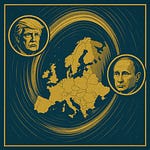Can the EU genuinely compete with the US and China in the race for artificial intelligence dominance? That’s the billion-euro question, and after the European Commission's April 9th announcement of its AI Continent Action Plan, the bloc’s answer is a confident, if cautious, “Yes—we’re all in.”
Let’s unpack what’s really happening—and whether Europe has a shot at becoming more than just a regulator in the AI era.
The Bold New Blueprint: €200 Billion and Five “Gigafactories”
The EU’s roadmap is clear:
Mobilize €200 billion in public-private investment under InvestAI
Build up to five AI gigafactories, each with 100,000 cutting-edge AI chips
Triple data center capacity by 2030
Make it all sustainable, in line with EU climate values
The ambition? Become a global AI hub—not in 2050, but in this decade.
But scale matters. While Europe is gearing up with billions, the US is already halfway through its $500 billion Stargate Initiative, and China’s state-led investments include a $47.5 billion semiconductor fund and multiple national AI clouds. As one observer put it:
“Europe’s trying to build, while the others are already running.”
Compute Power: A Mountain to Climb
On the 2024 TOP500 supercomputer list:
USA: 173 systems
China: 63
Germany: ~40
And Europe still imports most of its high-end AI chips. So while the gigafactories may close the gap in infrastructure, they won’t close it overnight.
The Brainpower Battle: Europe’s Research vs. America’s Models
Europe’s academic AI output is strong—over 100,000 papers in 2022, second only to China. But in actual AI systems?
US: 40 major models in 2024
China: 15
EU: 3
Europe has talent. But brain drain to Silicon Valley is real. Top researchers from France, Germany, and Italy are often lured away by higher salaries, faster-moving ecosystems, and prestige. The AI Continent Action Plan tries to fight back—with fellowships, visa programs, and an AI Skills Academy—but it’s still uphill.
Follow the Money (or Lack Thereof)
This is where it stings:
2023 AI VC funding:
US: $68 billion
China: $15 billion
EU: $8 billion
Europe’s lack of trillion-dollar tech giants means less capital, fewer unicorns, and more startups needing to go to the US for big rounds—sometimes relocating in the process.
The AI Act: Boon or Brake?
Europe’s AI Act is the world’s first comprehensive AI law. It bans certain uses (like social scoring), regulates “high-risk” AI, and aims to ensure trustworthy, human-centric technology.
But critics worry it may slow down innovation. The Commission is already planning a mid-2025 AI Act Service Desk to help companies navigate compliance—and is open to easing some burdens.
Meanwhile:
US: light-touch, mostly voluntary
China: strict control, especially for generative AI
Three models, three philosophies:
EU bets on trust
US bets on speed
China bets on alignment with national goals
Which one wins? That depends on execution—and trust.
Europe’s Edge: Playing to Its Strengths
Rather than chasing consumer platforms or defense AI, the EU is focusing on what it does best:
Healthcare
Automotive & transport
Advanced manufacturing
Sustainability & climate tech
Think: AI for diagnostics in public hospitals, for autonomous driving in German cars, for efficient energy grids under the Green Deal. If AI can help Europe excel in these sectors, it may not need to copy Silicon Valley or Shenzhen—it could carve its own path.
The Big Ifs: Will It Be Enough?
By 2030, Europe might not lead the world in AI models or military applications. But could it become a credible third power in global AI—a force for trustworthy, industrial-strength, ethically grounded innovation?
That depends on four big questions:
Will the €200 billion actually deliver?
Can Europe retain and attract top talent?
Will regulation balance trust with speed?
Can EU industry truly adopt and scale AI?
The AI Continent Action Plan is a serious play. It’s not window dressing. But the gap is real, and the race is already underway.
Still, if Europe succeeds, we may see something powerful emerge—not just “AI made in Europe,” but AI that reflects European values.
A Multipolar AI World? Yes, Please.
Imagine a future where AI isn’t shaped by just two powers. Where Europe is not just a referee but a builder. Where trust and transparency are part of the global AI standard—not an afterthought.
That future may be tough to reach. But April 9 marked the moment Brussels said:
“We’re not watching from the sidelines anymore.”
Sources:
European Commission, AI Continent Action Plan (April 2025)
Stanford HAI, 2025 AI Index
Politico EU, “EU opens door to reworking AI rulebook”
McKinsey, AI Adoption in Europe (2023)











